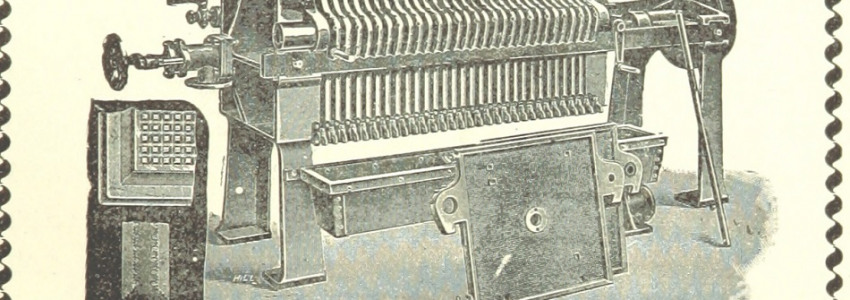
Kitmondo
25 Nov 2014
This article was originally published in Electrochemical and Metallurgical Industry Publication of February 1907. Information within this article is therefore correct as of 1907. The publication of this material aims to provide historical insight on the subject and its place in industry.
During the past years, we have repeatedly recorded new developments in the treatment and filtering of slimes in the cyanide process, relating especially to regrinding in tube mills and to the use of filter presses for separating the slimes from the cyanide solution in which the precious values are dissolved. This method apparently originated in Western Australia, but now gradually conquers the world of good metallurgy and finds especially growing application in this country.
This 5-ton filter press, built by Messrs. William R. Perrin & Co. embodies the best features of the foreign type of press which is so successfully used for the treating and washing of slimes. This filter press is of the kind known as "flush plate and division frame type," in which the plates are flat without recesses, and the chamber is formed by a division frame, the width of which determines the thickness of the cake. In this press all feed and exit channels are formed in projecting lugs, and are made tight by means of rubber rings set into the metal surfaces, thus allowing the use of clothes that do not have to be perforated to match the feed and exit channels, in this way saving a great amount of time and inconvenience in setting up and admitting of a much tighter press.
The exit is provided through a drip cock at the bottom of each plate or is arranged to pass through a closed channel extending through the press. The former plan has the advantage of locating a defective cloth on the press, and enables that particular plate to be cut out by closing its particular drip cock, through which a cloudy solution would be passing. The closed delivery channel, on the other hand, saves a little time in the operation of the press, there being no cocks to open and close each time the press is filled, and where the final solutions are strained through a clarifying press to remove all trace of solids, the closed delivery type may be considered desirable.
The arrangement of channels in this press is such that the treating solution or wash water must pass through the cakes from one side to the other in the most direct and uniform manner, and the drying of the cakes is effected with complete satisfaction by passing compressed air through the press.
Another type of filter press, built by William R. Perrin & Co. is for the separation of the precipitates in the chlorination process. This type has been adopted as the standard by the chlorination plants in Colorado and elsewhere. With this type of press, filter paper is used in conjunction with filter cloths, and the paper is stripped off and burned to recover the values. The cloth is eventually burned for the same reason. These presses are universal of the closed delivery type, and no trouble is experienced on account of the defective filtering surfaces when the presses are fitted up with ordinary care.
The same form of press which is used for the chlorination process is recommended for the separation of zinc dust precipitates in the cyanide process.
Messrs. William R. Perrin & Co. also build a round-pattern center-feed type of filter press of the simplest construction for general quick separation of solids held in suspension and for drying the same into solid cakes.
Image Credit: The British Library
















